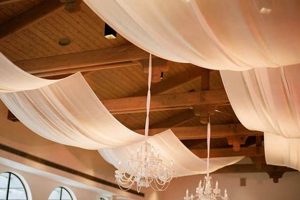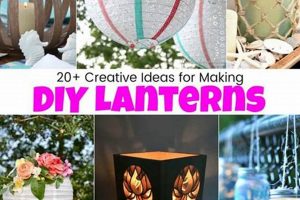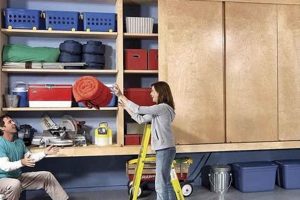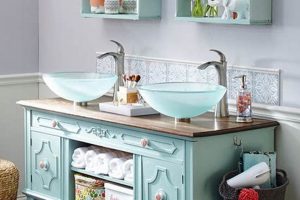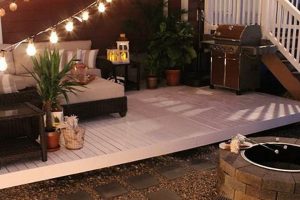Constructing a secure and functional enclosure for caprines through do-it-yourself methods involves a variety of planning and building considerations. These projects often entail utilizing readily available materials and applying practical construction techniques to create a safe and comfortable environment for the animals. For example, a basic structure might consist of wooden posts, wire fencing, and a sheltered area to protect goats from the elements.
Proper housing is fundamental to the well-being of goats. It offers protection from predators, adverse weather conditions, and potential injuries. Furthermore, a well-designed enclosure facilitates efficient management practices, such as feeding, cleaning, and health monitoring. Historically, farmers and homesteaders have relied on resourcefulness and ingenuity to develop cost-effective and suitable housing solutions for their livestock, tailoring them to specific environments and herd sizes.
Subsequent sections will delve into key aspects of designing and building enclosures, including material selection, structural considerations, fencing techniques, shelter options, and essential safety precautions. These elements are crucial for ensuring the long-term health, safety, and productivity of goats within a self-constructed environment.
Tips for Constructing Goat Enclosures
Creating a durable and secure space for goats requires careful planning and execution. The following recommendations outline key considerations for successful implementation.
Tip 1: Prioritize Perimeter Security: Robust fencing is paramount to contain goats and deter predators. Woven wire fencing, at least four feet high, offers a reliable barrier. Reinforce the bottom with buried wire or boards to prevent escape through digging.
Tip 2: Select Durable Materials: Opt for pressure-treated lumber for posts and framing to resist rot and insect damage. Metal roofing provides long-lasting protection from the elements.
Tip 3: Incorporate Adequate Shelter: Goats require protection from sun, rain, and wind. A three-sided shed or lean-to provides sufficient shelter. Ensure the shelter is large enough to accommodate all goats comfortably.
Tip 4: Design for Efficient Cleaning: A sloping floor in the shelter facilitates drainage and simplifies cleaning. Regularly remove manure to maintain hygiene and prevent the spread of disease.
Tip 5: Consider Gate Placement and Functionality: Gates should be wide enough to accommodate equipment and easy to operate. Position gates strategically for efficient movement of goats and supplies.
Tip 6: Provide Enrichment and Activity: Goats are intelligent and require mental stimulation. Incorporate features such as climbing structures, logs, or mineral licks to prevent boredom and destructive behavior.
Tip 7: Plan for Future Expansion: Anticipate potential herd growth when designing the enclosure. Allocate sufficient space for additional goats and potential future structures.
Tip 8: Ensure Proper Ventilation: Adequate airflow is essential to prevent the buildup of ammonia and moisture within the shelter. Install vents or leave gaps under the eaves to promote circulation.
By following these guidelines, builders can establish a safe, healthy, and productive environment for goats, minimizing maintenance and maximizing animal well-being.
The next section will explore common pitfalls to avoid during the construction process, ensuring long-term functionality and safety.
1. Security
Security represents a primary concern in self-constructed goat enclosures. Adequate protective measures are vital to safeguard livestock from predators and prevent escapes, directly impacting the animals’ well-being and the owner’s peace of mind.
- Perimeter Fencing Integrity
The integrity of the perimeter fence is crucial. The fence must be of sufficient height (at least four feet) to deter jumping, and the mesh spacing must be small enough to prevent goats from squeezing through or getting their heads stuck. Reinforcement at the bottom, such as buried wire or concrete footers, thwarts digging attempts. Neglecting these factors can lead to frequent escapes and increased vulnerability to predation.
- Predator Deterrence Measures
Predator deterrence extends beyond basic fencing. Livestock guardian animals, such as dogs or llamas, can provide an added layer of protection. Motion-activated lights and alarms can deter nocturnal predators. Regular inspection and maintenance of the fence line are also critical, as even small breaches can be exploited. Failure to implement these measures increases the risk of livestock losses.
- Gate Security and Design
Gates represent a potential weak point in the enclosure. They must be sturdily constructed and properly latched to prevent goats from pushing them open. Double-latching mechanisms or gravity latches offer enhanced security. Gates should swing inward to prevent goats from pushing outward and escaping. Inadequate gate design compromises the entire enclosure’s security.
- Internal Pen Divisions
Internal pen divisions, while not directly related to external security, contribute to overall safety by managing herd dynamics. Sturdy internal fencing prevents bullying and allows for the separation of goats by age, sex, or health status. This reduces the risk of injuries and facilitates targeted care. Poorly constructed internal divisions can lead to increased stress and potential harm within the herd.
The elements detailed above underscore the multifaceted nature of security in constructing goat enclosures. Each facet, from perimeter fencing to internal divisions, plays a crucial role in ensuring the animals’ safety and well-being. A comprehensive and diligent approach to security is paramount for successful caprine management.
2. Durability
The longevity and effectiveness of any self-constructed goat enclosure directly correlate with its inherent resilience to environmental factors and animal-induced wear and tear. Durability, therefore, is not merely a desirable attribute but a fundamental requirement for ensuring the long-term safety and well-being of the caprine inhabitants.
- Material Selection and Weather Resistance
The choice of construction materials dictates the enclosure’s ability to withstand weathering. Pressure-treated lumber resists rot and insect infestation, while metal roofing provides superior protection against rain and snow compared to organic materials. For fencing, galvanized or coated wire offers better resistance to corrosion than untreated alternatives. The failure to select weather-resistant materials results in premature degradation, increasing maintenance demands and potentially compromising the structure’s integrity.
- S
tructural Integrity and Load-Bearing CapacityThe structural framework must be capable of withstanding both static loads, such as the weight of the roofing and fencing, and dynamic loads, including wind pressure and animal impact. Properly braced posts, reinforced joints, and adequate footing depth are essential to prevent structural failure. Neglecting load-bearing capacity calculations can lead to collapse under adverse conditions, posing a significant risk to the goats.
- Resistance to Animal-Induced Damage
Goats are naturally inclined to rub against, climb on, and chew on enclosure structures. The materials and construction techniques must account for this behavior. Smooth, non-toxic surfaces minimize the risk of injury, while reinforced corners and edges prevent chewing damage. Selecting materials that are inherently resistant to goat behavior reduces the need for frequent repairs and extends the lifespan of the enclosure.
- Maintenance and Repair Accessibility
Even with the most durable materials and construction, periodic maintenance and repairs are inevitable. The design should facilitate easy access for inspection and repair. Replaceable components and modular construction allow for targeted repairs without requiring extensive reconstruction. Neglecting maintenance access can lead to minor issues escalating into major structural problems, shortening the enclosure’s overall lifespan.
The aforementioned elements underscore the interconnectedness of material selection, structural design, and maintenance considerations in determining the durability of DIY goat enclosures. A proactive approach to these aspects is essential for creating a lasting and reliable environment for caprine livestock.
3. Accessibility
Effective implementation of self-constructed goat enclosures necessitates a focus on accessibility, directly impacting the efficiency of animal management and overall operational practicality. The ease with which individuals can navigate, clean, and maintain the enclosure is a critical design consideration. For instance, a narrow gate restricts the passage of equipment necessary for manure removal, whereas an overly complex latching mechanism can impede swift access in emergency situations. A well-planned enclosure will incorporate features that streamline routine tasks and facilitate prompt intervention when required. Accessibility is therefore not merely a convenience but a crucial element influencing the functionality and usability of DIY goat pen ideas.
The significance of accessibility manifests in various practical applications. Manure management, a recurring chore, is significantly simplified by wide access points capable of accommodating wheelbarrows or small tractors. Similarly, providing easy access to water troughs and feeding stations reduces the labor involved in daily care. Furthermore, accessibility is essential for conducting health checks and administering medications, enabling efficient and stress-free handling of the animals. A poorly designed enclosure, lacking consideration for accessibility, can lead to increased labor costs, potential safety hazards, and compromised animal welfare.
In summation, integrating accessibility into the planning and construction of DIY goat enclosures is paramount for optimizing functionality and minimizing operational challenges. The conscious inclusion of design elements that facilitate efficient movement, maintenance, and animal handling directly translates to improved productivity and reduced strain on resources. Neglecting this facet can result in long-term inefficiencies and potential compromises in both animal care and overall farm management.
4. Cleanliness
Maintaining hygiene within self-constructed goat enclosures is paramount for preventing disease outbreaks and promoting animal well-being. The design and construction of the structure should prioritize ease of cleaning and sanitation to mitigate the risks associated with unsanitary conditions. A focus on cleanliness in the conception of diy goat pen ideas translates directly into healthier, more productive livestock.
- Floor Design and Drainage
The floor’s composition and slope are crucial for effective drainage. Impermeable surfaces, such as concrete with a slight gradient, facilitate the runoff of urine and cleaning solutions. Adequate drainage prevents the accumulation of moisture, which fosters bacterial and parasitic growth. Conversely, porous materials like dirt or wood can harbor pathogens, increasing the risk of infection. Inadequate drainage leads to unsanitary conditions and potential health issues within the herd.
- Manure Management Systems
Efficient removal of manure is essential for maintaining a hygienic environment. Regular cleaning schedules, coupled with easily accessible manure collection points, minimize the buildup of waste. Composting systems located away from the enclosure can transform manure into a valuable resource while reducing odor and fly populations. Ineffective manure management contributes to the spread of disease and environmental pollution.
- Ventilation and Air Quality
Proper ventilation is vital for dissipating ammonia and other noxious gases that accumulate from decomposing waste. Adequate airflow reduces moisture levels, preventing the growth of mold and bacteria. Cross-ventilation designs, incorporating strategically placed openings, promote air circulation without creating drafts. Insufficient ventilation compromises air quality, leading to respiratory problems and increased susceptibility to illness.
- Sanitization Protocols
Regular disinfection of surfaces and equipment is crucial for eliminating pathogens. Using appropriate sanitizing agents on feeders, waterers, and other frequently contacted surfaces minimizes the transmission of disease. Rotational grazing and periodic pen rest periods further reduce pathogen loads in the environment. Neglecting sanitization protocols allows pathogens to proliferate, increasing the risk of outbreaks and impacting overall herd health.
The interrelation of floor design, manure management, ventilation, and sanitization protocols underscores the multifaceted nature of cleanliness in diy goat pen ideas. A holistic approach, incorporating these elements, is essential for creating a sanitary and healthy environment for caprine livestock, minimizing the potential for disease and maximizing productivity.
5. Shelter
Adequate shelter constitutes an indispensable element within the broader scope of constructing goat enclosures. It directly impacts the animals’ well-being, productivity, and overall resilience to environmental stressors. Integrating suitable protective structures within the design phase is critical for ensuring the long-term success of self-constructed caprine housing.
- Protection from Inclement Weather
Shelter’s primary function is to shield goats from adverse weather conditions, including rain, snow, wind, and intense sunlight. Exposure to prolonged periods of inclement weather can lead to hypothermia, pneumonia, and decreased milk production. A three-sided struc
ture, oriented to block prevailing winds, provides basic protection. Roofed areas prevent rain and snow accumulation, reducing the risk of respiratory ailments. The integration of appropriate shelter mitigates weather-related health risks and enhances animal comfort. - Temperature Regulation
Shelter aids in maintaining a stable internal temperature, crucial for goat physiology. In winter, enclosed spaces trap body heat, reducing energy expenditure required for thermoregulation. In summer, shade structures prevent overheating and heat stress, which can impair fertility and growth rates. Proper ventilation within the shelter is essential to prevent the buildup of ammonia and excessive humidity, optimizing temperature regulation and air quality. The design and orientation of the shelter should take into account seasonal temperature variations to provide optimal climate control.
- Predator Deterrence
A well-constructed shelter offers a degree of protection from predators. Enclosed or partially enclosed structures provide a refuge where goats can retreat from perceived threats. Solid walls and secure doors deter access by predators such as coyotes, dogs, and foxes. Locating the shelter close to human activity or other livestock can further reduce predation risk. While shelter is not a complete substitute for robust perimeter fencing, it serves as an additional layer of security, minimizing vulnerability to predation.
- Disease Prevention and Management
Shelter design can contribute to disease prevention by promoting hygiene and reducing exposure to pathogens. Dry bedding materials, such as straw or wood shavings, absorb moisture and minimize the growth of bacteria. Adequate ventilation reduces humidity levels, inhibiting the proliferation of mold and other harmful microorganisms. Easily cleaned surfaces facilitate disinfection and prevent the buildup of contaminants. Regular cleaning and maintenance of the shelter are essential for maintaining a sanitary environment and minimizing the risk of disease outbreaks. Thoughtful integration of shelter design with appropriate sanitation practices contributes to a healthier and more productive goat herd.
The various facets discussed above highlight the critical role that shelter plays within diy goat pen ideas. A comprehensive approach to shelter design, considering factors such as weather protection, temperature regulation, predator deterrence, and disease prevention, is crucial for creating a safe, comfortable, and productive environment for caprine livestock. Effective shelter contributes significantly to the overall success and sustainability of self-constructed goat enclosures.
6. Layout
The spatial arrangement within self-constructed goat enclosures, commonly referred to as layout, significantly influences animal welfare, management efficiency, and overall productivity. A thoughtfully conceived layout mitigates stress, reduces the potential for injury, and streamlines routine tasks. Conversely, a poorly planned arrangement can lead to overcrowding, increased aggression, and difficulty in providing adequate care. Therefore, integrating layout considerations into the design phase is paramount when implementing diy goat pen ideas.
Effective layout principles include providing ample space per animal, creating distinct zones for feeding, sleeping, and exercise, and minimizing blind corners or dead ends that can trap or intimidate goats. For instance, overcrowding in a limited space can escalate competition for resources, leading to undernourishment in weaker individuals. Similarly, a convoluted layout with insufficient escape routes can heighten anxiety and increase the risk of accidents during routine handling. Real-world examples demonstrate that enclosures with well-defined areas and clear pathways exhibit lower levels of stress-related behaviors and improved overall herd health. The practical significance of this understanding lies in the ability to proactively address potential problems through informed design choices.
In summary, layout is an indispensable component of successful self-constructed goat enclosures. Careful consideration of spatial arrangement principles optimizes animal welfare, enhances management efficiency, and minimizes potential risks. While challenges may arise in adapting layouts to specific site constraints or budgetary limitations, prioritizing these considerations yields tangible benefits in terms of herd health, productivity, and long-term sustainability.
Frequently Asked Questions
The following addresses common inquiries and clarifies misconceptions pertaining to the creation of secure and functional spaces for caprine livestock.
Question 1: What constitutes an adequate minimum size for a goat enclosure?
Adequate space allocation is contingent upon the number of goats and their breed. As a general guideline, each goat requires a minimum of 20 square feet in an outdoor pen and 10 square feet within a sheltered area. Insufficient space can lead to increased competition, stress, and the spread of disease.
Question 2: What type of fencing is most effective for goat containment?
Woven wire fencing with a minimum height of four feet is generally considered the most effective option. The mesh size should be small enough to prevent goats from pushing through or getting their heads stuck. Electric fencing can be added as a deterrent, particularly for goats prone to escaping. Barbed wire is not recommended due to the risk of injury.
Question 3: Is shelter a mandatory component of a goat enclosure?
Provision of shelter is essential for protecting goats from inclement weather, including rain, snow, wind, and excessive sun. A three-sided structure with a roof provides adequate protection. The shelter should be large enough to accommodate all goats comfortably. Neglecting shelter can lead to hypothermia, heat stress, and decreased productivity.
Question 4: What materials are best suited for constructing goat enclosures?
Pressure-treated lumber is recommended for posts and framing due to its resistance to rot and insect damage. Metal roofing provides durable protection from the elements. Galvanized or coated wire is preferable for fencing to prevent corrosion. Avoid using materials that are toxic or easily chewed by goats.
Question 5: How can digging under fences be prevented?
Burying the bottom of the fence at least six inches below the ground can deter digging. Alternatively, attaching a wire apron to the bottom of the fence and extending it outward can prevent goats from digging underneath. Regular inspection of the fence line is crucial for identifying and addressing any digging attempts.
Question 6: What are the primary considerations for gate placement and design?
Gates should be strategically located to facilitate efficient movement of goats and equipment. They should be wide enough to accommodate wheelbarrows or small tractors. Secure latching mechanisms are essential to prevent goats from opening the gates. Gates should swing inward to prevent goats from pushing outward and escaping.
In essence, the successful construction of a goat enclosure depends on careful planning, appropriate material selection, and a commitment to maintaining a safe and hygienic environment. Adherence to these principles will contribute to the long-term health and productivity of the caprine herd.
The following section will delve into the cost implications and potential savings associated with constructing one’s own goat pen.
Conclusion
The preceding sections have comprehensively examined the multifaceted considerations inherent in “diy goat pen ideas”. From initial planning and material selection to the critical aspects of security, durability, shelter, cleanliness, and layout, the intention has been to provide a thorough and informative guide. A well-executed project requires careful attention to detail, balancing cost-effectiveness with the essential needs of caprine livestock.
The ultimate success of a self-constructed enclosure hinges upon a commitment to ongoing maintenance and adaptation. Observing animal behavior and adjusting the design as needed ensures a safe, productive, and sustainable environment. Diligence in these endeavors is not merely a recommendation but a necessity for responsible animal husbandry.



